上海交通大学:《复杂系统动力学计算机辅助分析》课程教学资源_Chapter 5_Planar Kinematic Modeling and Analysis

Chapter 5 Planar Kinematic Modeling and Analysis Modeling and analysis techniques 1. Draw a clear diagram of the system to be modeled 2. Select and number bodies and kinematic joints between pairs of bodies 3. Count the number of the constraint equations nh 4. Calculate DOF=3nb-nh 5. If DOF <=0,eliminate the redundant constraints 6. Define DOF drivers to specify the motion of the system 7. Make drawings of each body in the system,defining the body-fixed x'-y'frames and data required for each of the kinematic joints and drivers selected 8. Use a reasonable sketch or diagram of the system to estimate the position and orientation variables to initiate the assembly process of analysis
Chapter 5 Planar Kinematic Modeling and Analysis 1. Draw a clear diagram of the system to be modeled 2. Select and number bodies and kinematic joints between pairs of bodies 3. Count the number of the constraint equations nh 4. Calculate DOF=3nb-nh 5. If DOF < = 0, eliminate the redundant constraints 6. Define DOF drivers to specify the motion of the system 7. Make drawings of each body in the system, defining the body-fixed x’-y’ frames and data required for each of the kinematic joints and drivers selected 8. Use a reasonable sketch or diagram of the system to estimate the position and orientation variables to initiate the assembly process of analysis Modeling and analysis techniques
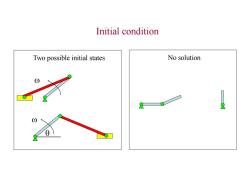
Initial condition Two possible initial states No solution 0
Initial condition Two possible initial states w w No solution q

Initial condition assembly of the system The user may employ graphical estimates of the position and orientation of each body to create g o,how to obtain the initial assembled configuration g a The objective is to minimize 平(q,to,r)=q-q°)y(q-q)+rΦ'(q,to)(q,t) to get q(r) r>0 is a weighting constant that places relative emphasis on deviation from the qo ga lim g(r)
Initial condition assembly of the system The user may employ graphical estimates of the position and orientation of each body to create q 0 , how to obtain the initial assembled configuration q a ? The objective is to minimize ( , , ) ( , ) ( , ) 0 0 0 0 0 t r r t t T T q q q q q q q r > 0 is a weighting constant that places relative emphasis on deviation from the q0 lim (r) r a q q to get q(r)
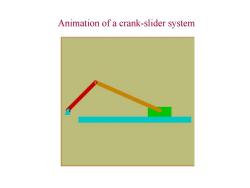
Animation of a crank-slider system
Animation of a crank-slider system
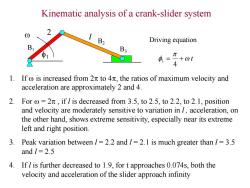
Kinematic analysis of a crank-slider system B2 Driving equation B3 1= +ot 4 l.If o is increased from2πto4π,the ratios of maximum velocity and acceleration are approximately 2 and 4. 2.For o=2n,if l is decreased from 3.5,to 2.5,to 2.2,to 2.1,position and velocity are moderately sensitive to variation in 1,acceleration,on the other hand,shows extreme sensitivity,especially near its extreme left and right position. 3.Peak variation between /=2.2 and /2.1 is much greater than /=3.5 and 1 2.5 4. If is further decreased to 1.9,for t approaches 0.074s,both the velocity and acceleration of the slider approach infinity
Kinematic analysis of a crank-slider system w f1 Driving equation w t f 4 1 1. If w is increased from 2 to 4, the ratios of maximum velocity and acceleration are approximately 2 and 4. 2. For w = 2 , if l is decreased from 3.5, to 2.5, to 2.2, to 2.1, position and velocity are moderately sensitive to variation in l , acceleration, on the other hand, shows extreme sensitivity, especially near its extreme left and right position. 3. Peak variation between l = 2.2 and l = 2.1 is much greater than l = 3.5 and l = 2.5 4. If l is further decreased to 1.9, for t approaches 0.074s, both the velocity and acceleration of the slider approach infinity 2 l B1 B2 B3
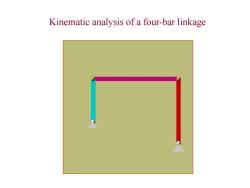
Kinematic analysis of a four-bar linkage
Kinematic analysis of a four-bar linkage
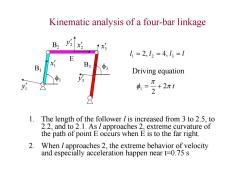
Kinematic analysis of a four-bar linkage B2吃 x2 ↑x 11=2,12=4,13=1 E B B3 3 Driving equation y 1.The length of the follower is increased from 3 to 2.5,to 2.2,and to 2.1.As approaches 2,extreme curvature of the path of point E occurs when E is to the far right. 2.When approaches 2,the extreme behavior of velocity and especially acceleration happen near t=0.75 s
Kinematic analysis of a four-bar linkage Driving equation t f 2 2 1 1. The length of the follower l is increased from 3 to 2.5, to 2.2, and to 2.1. As l approaches 2, extreme curvature of the path of point E occurs when E is to the far right. 2. When l approaches 2, the extreme behavior of velocity and especially acceleration happen near t=0.75 s f1 B1 1 x 1 y 2 y 3 y 2 x 3 x f3 B2 B3 l l l l 1 2 3 2, 4, E

Singular configuration 2c0s攻+4c0s2-lc0s4,-4 Φ= 2sin +4sin,-Isin +1-2 =0 42, -2sind-4sin2 Isin3 -1c0sφ3 =41sin g2 cos-41 cos2 sin 2c0s中,4cos中2 1 0 0 =41 sin(2-03) For sin(4,-4)=0,D,=0 Singularity occurs
Singular configuration 0 t l l l f f f f f f f 2 2 2sin 4sin sin 2 2cos 4cos cos 4 1 1 2 3 1 2 3 1 0 0 2cos 4cos cos 2sin 4sin sin 1 2 3 1 2 3 f f f f f f l l q 4 sin( ) 4 sin cos 4 cos sin 2 3 2 3 2 3 f f f f f f l l l q For sin( ) 0, 0 f2 f3 q Singularity occurs

(1)For=0 2c0s4,+(4-I)cosp2=4 2sin,+(4-l)sinp2=2-1 4+(4-)2+4(4-1)cos(-2)=16+(2-1)2 (4-)cos(4,-p2)=1 Since cos(,-中2≤1 1≤2 For /=2 cos(φ,-中2)=1 41=42=0 cos=1 4=42=中3=0 Bifurcation For /<2 cos(4,-2)=l/(4-)4,=42+arccos[l1(4-I] Lock up
(1) For l l l 2sin (4 )sin 2 2cos (4 ) cos 4 1 2 1 2 f f f f f2 f3 0 2 1 2 2 4 (4 l) 4(4 l) cos(f f ) 16 (2 l) (4 l) cos( ) l f1 f2 Since cos(f1 f2 ) 1 l 2 For l = 2 cos(f1 f2 ) 1 f1 f2 0 For l < 2 arccos[ /(4 )] 1 2 f f l l cosf1 1 f1 f2 f3 0 cos( ) /(4 ) 1 2 f f l l w w Bifurcation Lock up
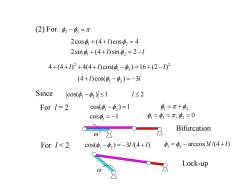
(2)For中2-43=π 2cos4,+(4+l)c0sp2=4 2sin+(4+1)sin=2-1 4+(4+)2+4(4+)cos(-p2)=16+(2-1)2 (4+1)cos(,-42)=-31 Since cos(,-中2≤1 1≤2 For 1=2 cos(0,-p2)=1 中1=π+中2 C0s,=-1 41=43=π,中2=0 008 Bifurcation For /<2 cos(4-φ2)=-31/(4+1) =2 -arccos 31/(4+1) Lock-up
(2) For l l l 2sin (4 )sin 2 2cos (4 ) cos 4 1 2 1 2 f f f f f2 f3 2 1 2 2 4 (4 l) 4(4 l) cos(f f ) 16 (2 l) (4 l) cos( ) 3l f1 f2 Since cos(f1 f2 ) 1 l 2 For l = 2 cos(f1 f2 ) 1 f1 f2 For l < 2 cos( ) 3 /(4 ) 1 2 f f l l cosf1 1 f1 f3 , f2 0 arccos3 /(4 ) 1 2 f f l l w w Bifurcation Lock-up
按次数下载不扣除下载券;
注册用户24小时内重复下载只扣除一次;
顺序:VIP每日次数-->可用次数-->下载券;
- 上海交通大学:《复杂系统动力学计算机辅助分析》课程教学资源_Chapter 4_Flow chart for kinematics.doc
- 上海交通大学:《复杂系统动力学计算机辅助分析》课程教学资源_Chapter 4_Char4-Numerical methods.ppt
- 上海交通大学:《复杂系统动力学计算机辅助分析》课程教学资源_Chapter 3_CHAP3.7-singularity.ppt
- 上海交通大学:《复杂系统动力学计算机辅助分析》课程教学资源_Chapter 3_CHAP3.6-Position, velocity and acceleration analysis_1.ppt
- 上海交通大学:《复杂系统动力学计算机辅助分析》课程教学资源_Chapter 3_CHAP3.6-Position, velocity and acceleration analysis.ppt
- 上海交通大学:《复杂系统动力学计算机辅助分析》课程教学资源_Chapter 3_CHAP3.5-Driving constraint.ppt
- 上海交通大学:《复杂系统动力学计算机辅助分析》课程教学资源_Chapter 3_CHAP3.4-Gears.ppt
- 上海交通大学:《复杂系统动力学计算机辅助分析》课程教学资源_Chapter 3_CHAP3.3-Relative Constraint.ppt
- 上海交通大学:《复杂系统动力学计算机辅助分析》课程教学资源_Chapter 3_CHAP3.2-Absolute constraints.ppt
- 上海交通大学:《复杂系统动力学计算机辅助分析》课程教学资源_Chapter 3_CHAP3.1-Basic Concepts.ppt
- 上海交通大学:《复杂系统动力学计算机辅助分析》课程教学资源_2014复杂系统动力学试卷.pdf
- 上海交通大学:《力学仿生——启示与探索》课程教学资源(讲课讲稿)邵炜桓.pptx
- 上海交通大学:《力学仿生——启示与探索》课程教学资源(讲课讲稿)第四组-第三次作业-初稿.pptx
- 上海交通大学:《力学仿生——启示与探索》课程教学资源(讲课讲稿)第三次作业要求.pdf
- 上海交通大学:《力学仿生——启示与探索》课程教学资源(讲课讲稿)第一次作业打分表.docx
- 上海交通大学:《力学仿生——启示与探索》课程教学资源(讲课讲稿)周一浩.pptx
- 上海交通大学:《力学仿生——启示与探索》课程教学资源(讲课讲稿)力学仿生第三次作业.pptx
- 上海交通大学:《力学仿生——启示与探索》课程教学资源(讲课讲稿)分组.docx
- 上海交通大学:《力学仿生——启示与探索》课程教学资源(讲课讲稿)仿水黾机器人(第三组).pptx
- 上海交通大学:《力学仿生——启示与探索》课程教学资源(讲课讲稿)二参数温度模型.docx
- 上海交通大学:《复杂系统动力学计算机辅助分析》课程教学资源_Chapter 5_Modeling for Example 4.doc
- 上海交通大学:《复杂系统动力学计算机辅助分析》课程教学资源_Chapter 5_Modeling for Example 5.doc
- 上海交通大学:《复杂系统动力学计算机辅助分析》课程教学资源_Chapter 5_Modeling for Example2.doc
- 上海交通大学:《复杂系统动力学计算机辅助分析》课程教学资源_Chapter 6_Char6.1-Equations of motion of a planar rigid body.ppt
- 上海交通大学:《复杂系统动力学计算机辅助分析》课程教学资源_Chapter 6_Char6.2 Virtual work and generalized force.ppt
- 上海交通大学:《复杂系统动力学计算机辅助分析》课程教学资源_Chapter 6_Char6.2 Virtual work and generalized force.ppt
- 上海交通大学:《复杂系统动力学计算机辅助分析》课程教学资源_Chapter 6_Char6.3 Equations of motion of constrained planar.ppt
- 上海交通大学:《复杂系统动力学计算机辅助分析》课程教学资源_Chapter 6_Char6.4 Inverse Dynamics.ppt
- 上海交通大学:《复杂系统动力学计算机辅助分析》课程教学资源_Chapter 6_Char6.5 Equilibrium Problem.ppt
- 上海交通大学:《复杂系统动力学计算机辅助分析》课程教学资源_Chapter 6_Char6.6 Constraint reaction forces.ppt
- 上海交通大学:《复杂系统动力学计算机辅助分析》课程教学资源_Chapter 7_chap7-Numerical Methods in Dynamics.ppt
- 上海交通大学:《复杂系统动力学计算机辅助分析》课程教学资源_Chapter 8_Planar Dynamic Modeling and Analysis.ppt
- 上海交通大学:《复杂系统动力学计算机辅助分析》课程教学资源_Chapter 8_Modeling for Example 4.doc
- 上海交通大学:《复杂系统动力学计算机辅助分析》课程教学资源_Chapter 8_Modeling for Example1.doc
- 上海交通大学:《复杂系统动力学计算机辅助分析》课程教学资源_Chapter 8_Modeling for Example2.doc
- 上海交通大学:《复杂系统动力学计算机辅助分析》课程教学资源_动力学上机_双摆动力学仿真说明.doc
- 上海交通大学:《复杂系统动力学计算机辅助分析》课程教学资源_动力学上机_双摆动力学逆问题说明.doc
- 上海交通大学:《复杂系统动力学计算机辅助分析》课程教学资源_动力学上机_静平衡条件说明.doc
- 上海交通大学:《复杂系统动力学计算机辅助分析》课程教学资源_动力学附加题.doc
- 上海交通大学:《复杂系统动力学计算机辅助分析》课程教学资源_双摆动力学仿真说明.doc
